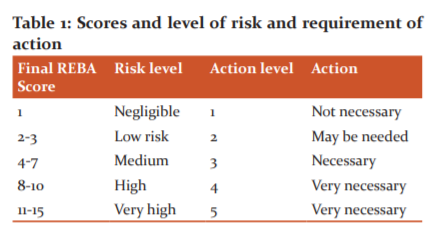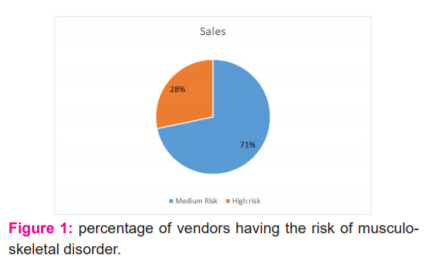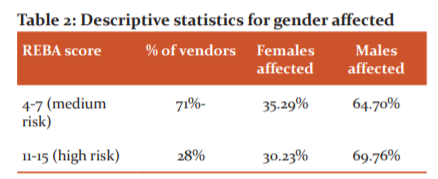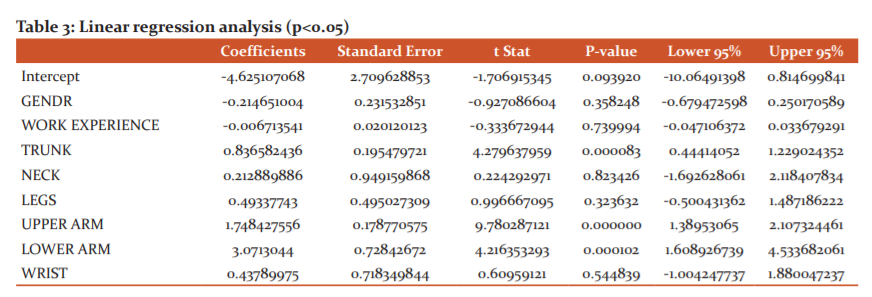IJCRR - 13(8), April, 2021
Pages: 62-66
Date of Publication: 25-Apr-2021
Print Article
Download XML Download PDF
Ergonomic Evaluation of Street Vendors as Determined by Rapid Entire Body Assessment Method
Author: Samiksha Sathe, Mrunal Baxi, Neha Chaudhary, Varsha Pawar, Swapnil Bhirange
Category: Healthcare
Abstract:Background: Musculoskeletal conditions are prevalent and their impact is pervasive. They are the most common cause of severe long-term pain and physical disability affecting the psychosocial status of affected people as well as their families and caretakers. In all occupations, incorrect working posture is the most important cause of musculoskeletal disorders. Objective: This study aimed to evaluate the work postures of street vendors using the Rapid Entire Body Assessment (REBA) method. Methods: Cross-sectional study was conducted. Work postures were assessed in 60 street vendors by employing the REBA method. Stratified sampling was used. Data were analyzed using Pearson's correlation and regression analysis was tested using SPSS software. Results: The results show that 71% of vendors had a high risk of developing musculoskeletal disorder.No significant relationship was found between age and REBA score (p= 0.1142, Pearson's correlation 0.2). The relationship between years of work experience and REBA score was also not significant (p =0.2463, Pearson's correlation 0.15). However, regression analysis revealed that trunk, upper arm and lower arm postures were mainly contributing to the REBA score, putting Street vendors at high risk of developing a musculoskeletal disorder. Conclusion: From this study, we concluded that task performed by the majority of street vendors possess a high risk of developing work-related musculoskeletal disorder requiring immediate measures. No relation was found between age and REBA score as well as years of work experience and REBA score. Trunk, upper arm and lower arm postures were influencing more to REBA scores.
Keywords: Rapid Entire Body Assessment, Ergonomic evaluation, Work-related musculoskeletal disorders, Body posture, Street vendors
Full Text:
INTRODUCTION
Improper body posture and long hours in front of these terminals can result in many health hazards, including fatigue and musculoskeletal disorders (MSDs). It has been stated that MSDs are the most common occupational health problem.1 The occupational disease is also known as occupational overuse syndrome covers pathological conditions aroused by prolonged work, exertion, interaction with harmful factors inherent in materials, equipment or working environment. Some diseases are caused by etiological factors inherent in circumstances in which workers work. Bad posture, repeated physical effort or psychological stresses are contributing factor for occupational diseases.2,3 The risk of work-related musculoskeletal disorders predominantly low back pain is because of long work hours and strenuous activities3. Poor working condition and the absence of strategies for work injury prevention are responsible for the increase in work-related musculoskeletal injuries. It is the most common injury faced at the workplaces in both developed and developing countries.4 Musculoskeletal disorders are the most common self-reported work-related illness and the leading cause of disability of people during the working years. This is also responsible for lost earnings, medical payments.1
Today hawking is an imperative origin of employment for an expansive number of urban poor as it requires low aptitudes and small financial contribution. Comprehensively characterized, a road merchant is an individual who offers merchandise or facilities available to be purchased to the general population without having an unalterable developed structure however with a portable mobile stall or with an impermanent static structure.5 The number of road merchants in the nation is assessed at around 10 million. A few investigations gauge that road merchants comprise around 2 % of the populace of the city. Road merchants have poor government disability and their working condition in the city open them to an assortment of security and medical problems. The SNDT-ILO research on Mumbai found that around 85 % of road sellers complained of issues identified with stress.5
Street vendors work includes twisting, bending, pushing heavy loads over the mobile cart, long-standing and long working hours.6 An ergonomic risk assessment can fundamentally identify the danger of occurrence of the musculoskeletal issue the initial phase in checking for MSDs is an ergonomic evaluation, which can take various forms, for example, Rapid whole Body Assessment [REBA].7 Since the time REBA has been presented, it demonstrated its incentive for postural evaluations of employments in a few word-related settings, including development industries8,9, supermarket staffs10, cloth manufacturers11, engine motor assembly industries12, firemen and crisis restorative professionals13, sawmill laborer14 and in medical clinic settings.15 The present investigation expected to recognize ergonomic hazard evaluation by observational strategy, REBA, as far as loading scores dependent on examination of the working attitude taken from Street merchants with portable stalls.
MATERIALS AND METHODS
This cross-sectional study was carried out in Nagpur, Maharashtra by observation. The checklist was examined by the investigator. A stratified sampling method was used to recruit the participants. Inclusion criteria include participant’s age 18-60 years. All males and females vendors, at least 1 year of work experience. Exclusion criteria were any postural deformities like scoliosis, kyphosis, and any history of recent injury/trauma or accident. Spinal surgery or any other surgery in any part of the body, limb length discrepancy, retired, pregnant females. Informed consent was obtained by the participants. Demographic data such as age gender, educational status and working experience, working hours each day were also recorded. Postures were analyzed by the REBA method. Each vendor’s body posture at the time was carefully observed (at least for 10 minutes). The worst and most frequent body postures were selected and according to the angulation of each body part, a score was given to the head, neck, body, upper limbs and lower limbs. The REBA worksheet is divided into two body segments, these sections are labelled as section A and section B. Section A covers the neck, trunk, and leg. The arm and wrist are covered in section B. Group A (Trunk, Neck and Legs) postures are scored first, then score Group B (Upper Arms, Lower Arms, and Wrists) postures for left and right. For each region, there is a posture scoring scale and additional adjustments which need to be considered and accounted for in the score.7
The scores were recorded in the second part of the checklist and the interpretation of the final REBA score was carried. Because REBA has different coding systems for different body parts and the possible minimum and maximum scores for each body part are different, it was not possible to determine the most badly postured body part ( Table1).

RESULTS
The study was carried out on 60 street vendors in Nagpur, Maharashtra. Considering the gender, 32% of participants were females and 68% were males. The mean age of the vendors was 38.56±7.60 years. Mean work experience is 17.36±6.37 ( Figure 1 and Table 2).
Considering the body posture (REBA score), the risk of developing musculoskeletal disorders among vendors was seen as following.


Relation between age and REBA score was analysed using the Pearsons correlation test. Data analysis revealed no significant relationship between age and REBA score (p= 0.1142, Pearson’s correlation 0.2). The relationship between years of work experience and REBA score was also not significant (p =0.2463, Pearson’s correlation 0.15) (Table 3).
This implies gender and years of work experience do not impact REBA, however, regression analysis shows that trunk, upper arm and lower arm was a significant predictor for risk level. This explained that if trunk, upper arm and lower arm posture is improved then the level of risk of musculoskeletal disorder will be reduced. Loading and forward bend postures to mobilize the stall has been shown to put the back, upper arm and lower arm in critical postures. These postures contribute to the higher scores in respective sections and over again to the final REBA score.

DISCUSSION
Musculoskeletal Disorders are a common health problem responsible for the major cause of disability. This includes economic loss affecting at the individual level, organizational level as well as societal level.16 A study done on shopkeepers in Dhaka showed the prevalence of 51% for low back pain amongst shopkeepers.6 Results showed that the majority of vendors were exposed to a high risk of developing a work-related musculoskeletal disorder. Physical work requirements that in the scientific literature have been specifically identified with LBP include heavy physical work, manual handling of materials, regular bending.17 A cross-sectional investigation to depict prevalence and attributes of musculoskeletal symptoms in an extensive French working population using a Nordic questionnaire showed that the prevalence of the musculoskeletal disorder in women were 83.8%.18 A study done on vegetable vendors concluded that the prevalence of low back pain in vendors is high.19 A bulletin released by WHO states that low back pain is associated with working bad postures such as bending forward heavily with one’s trunk, bending and twisting simultaneously with one’s trunk, a bent and twisted posture for long periods, and making repetitive movements with the trunk.20 Persistent standing at work has been appeared to be related to various conceivably grave health outcomes, for example, lower back and leg pain, cardiovascular issues, weariness, distress etc.21
One of the fundamental necessity for assessing work exercises is postural investigation. The danger of musculoskeletal injury related to the recorded position can be valuable in actualizing change in the working practices, with regards to full ergonomic work environment assessment. The hazard assessment contains different factors, for example, the labourer's collaboration, their size, the surrounding condition, other manual handling processes’ recurrence, the accessibility of resources and equipment and the workers’ capacity to recognize when a task is past his capacity and request help.21 REBA gives a fast and simple measure to evaluate a variety of working stances for the danger of WMSDs. It separates the body into areas to be coded independently, as per movement planes and offers a scoring framework for muscle action all through the whole body, inertly, dynamically, quick-changing or in an unsteady way and where manual handling may happen which is indicated as a coupling score as it is critical in the loads handling but may not generally be utilizing the hands. REBA likewise gives an action level with an indication of significance and requires minor materials.21
Ergonomic intervention to reduce musculoskeletal disorders includes engineering improvements which include rearranging, modifying, redesigning equipment. Mechanization of the stalls to reduce the musculoskeletal strain is possible. In areas, where mechanization is not possible, ergonomically correct measures to avoid musculoskeletal disorders, are to be taken. Limited evidence till now is available in this area to know the risk of musculoskeletal disorders among street vendors.
Behavioural and personal changes function by attempting to reduce the harmful effect of the risk factor by training in precise practice or improving the capability of worker (fitness and exercise programme). Personal protective equipment is intentional to work by putting a barrier in place between hazard and person.22,23 Studies on measurement of health indices and blood and body parameters were reported.24-26 Several studies on health issues of street vendors and Migrants were reported.27,28 Further research can be done to evaluate the effect of different Ergonomic intervention on the risk of developing a musculoskeletal disorder. The study has limitations that weight carried by the street vendors on their mobile stalls was not considered while assessing.
CONCLUSION
From this study, we concluded that task performed by the majority of street vendors possess a high risk of developing work-related musculoskeletal disorder requiring immediate measures. No relation was found between age and REBA score as well as years of work experience and REBA score. Trunk, upper arm and lower arm postures were influencing more to REBA scores.
Conflict of Interest: Nil
Source of Funding: Nil
References:
-
Akrouf Q, Crawford J, Shatti A, Kamel M. Musculoskeletal disorders ampng bank office workers in Kuwait. East Mediterranean Health J 2010; 16(1):217.
-
Gangopadhyay B. A study on the prevalence of upper extremity repetitive strains among the handloom weavers of West Bengal. J Human Ergo 2003;32:17-22.
-
Durlov S, Chakrabarty S, Chatterjee A. Prevalence of low back pain among handloom weavers in West Bengal, India. Int J Occupational Envt Health 2014;20(4):333-339.
-
Choobineh M, Hosseini M, Lahmi R, Khani. Musculoskeletal problems in Iranian Hand-woven carpet industry: Guidelines for workstation design. Applied Ergon 2007;38:617-624.
-
Dias SM. Overview of the Legal Framework for Inclusion of Informal Recyclers in Solid Waste Management in Brazil. Women in informal employment: globalizing and organizing.. cited 2018 December. WIEGO Policy Brief (Urban Policies) No 6. https://www.wiego.org/sites/default/files/publications/files/Dias_WIEGO_PB6.pdf.
-
Karahan A, Kav S, Abbasoglu A, Dogan N. Low back pain: prevalence and associated risk factors among hospital staff. J Adv Nurs 2009;65(3):516-24.
-
Highnett SAL. Rapid Entire Body Assessment (REBA). Appl Ergon 2000;31:201-5.
-
Kim S, Nussbaum M, Jia B. Low back injury risks during construction prefabricated (penalised) walls: effects of task and design factors. Ergonomics 2011;54: 60-71.
-
Rwamamara R. Assessment and analysis of workload in an industrialized construction process. Const Infor Quart 2007; 9(2):80-85.
-
Coyle A. Comparison of the rapid entire body assessment and the New Zealand manual handling “hazard control record”, for assessment of manual handling hazards in the supermarket industry. Work 2005; 24:111-116.
-
Erdinc O, Vayvay O. Ergonomics interventions improve quality in manufacturing: a case study. Int J Ind Syst Engg 2008; 3: 727-745.
-
Kim Y, Kang D, Koh S. Risk factors of work-related musculoskeletal symptoms among motor engine assembly plant workers. Korean J Occup Environ Med 2004; 16(4): 488-498.
-
Gentzler M, Stader S. Posture stress on fire-fighters and emergency medical technicians (EMTs) associated with repetitive reaching, bending, lifting, and pulling tasks. Work 2010; 37(3): 227-239.
-
Jones T, Kumar S. Comparison of ergonomic risk assessments in a repetitive high-risk sawmill occupation: Saw-filer. Int J Ind Ergon 2007; 37(9-10):744-753.
-
Janowitz I, Gillen M, Ryan G. Measuring the physical demands of work in hospital settings: Design and implementation of an ergonomics assessment. Appl Ergon 2006;37(5): 641-658.
-
Choobineh A, Tabatabaee S, Behzadi M. Musculoskeletal problems among workers of an Iranian sugar-producing factory. Int J Occup Saf Ergon 2009;15(4):419-24.
-
Tissot F, Messing K, Stock S. Studying the relationship between low back pain and working postures among those who stand and those who sit most of the working day. Ergonomics 2009;52(11):126-129.
-
Parot E, Descatha A, Ha C, Petit A, Leclerc A, Roquelaure Y. Prevalence of multisite musculoskeletal symptoms: a French cross-sectional working population-based study. BMC Musculoskeletal Disord 2012;122(13):241-245.
-
Sant S. Prevalence of Low Back Pain in Vegetable Vendors of Loni Village. Int J Health Sci Res 2017;7(8):56-59.
-
Ehrlich GE. Low back pain. Bulletin of the World Health Organization 2003;81(9):6716.
-
Madnani AI, Dababneh A. Rapid Entire Body Assessment: a literature review. Am J Engg Appl Sci 2016;9(1):107-18.
-
Norman R, Weels R. Ergonomic intervention for reducing musculoskeletal disorders: an overview, related issues and future directions. Waterloo: Royal Commission on Workers Compens Brit Col 1998;6(3):52-6.
-
Waters T, Dick R. Evidence of Health Risks Associated with Prolonged Standing at Work and Intervention Effectiveness. Rehabil Nurs 2015;40(3):148-165.
-
Gokhale MP. Agarwal CA, Ramdas PA. Correlation of Body Fat Distribution with Iron Profile and Haemoglobin Level in Young Overweight Females. Int J Pharmac Res 2019;11(1):1153–1156.
-
Wagh SP, Bhagat SP, Bankar N, Jain K. Relationship between Hypothyroidism and Body Mass Index in Women: A Cross-Sectional Study. Int J Curr Res Rev 2020;12(12):48–51.
-
Khanam N, Wagh V, Gaidhane AM, Quazi SZ. Assessment of Work-Related Musculoskeletal Morbidity, Perceived Causes and Preventive Activities Practiced to Reduce Morbidity among Brick Field Workers. Ind J Comm Health 2019; 31(2):213–219.
-
Regmi PR, van Teijlingen E, Mahato P, Aryal N, Jadhav N, Simkhada P, et al. The health of Nepali migrants in India: A qualitative study of lifestyles and risks. Int J Envt Res Pub Heal 2019;16(19): 135-139.
-
Regmi PR, Van TV, Mahato V, Aryal N, Jadhav M, Simkhada P, et al. The Health of Nepali Migrants in India: A Qualitative Study of Lifestyles and Risks. Int J Envt Res Public Health 2019;16(19):251-254.
|






 This work is licensed under a Creative Commons Attribution-NonCommercial 4.0 International License
This work is licensed under a Creative Commons Attribution-NonCommercial 4.0 International License